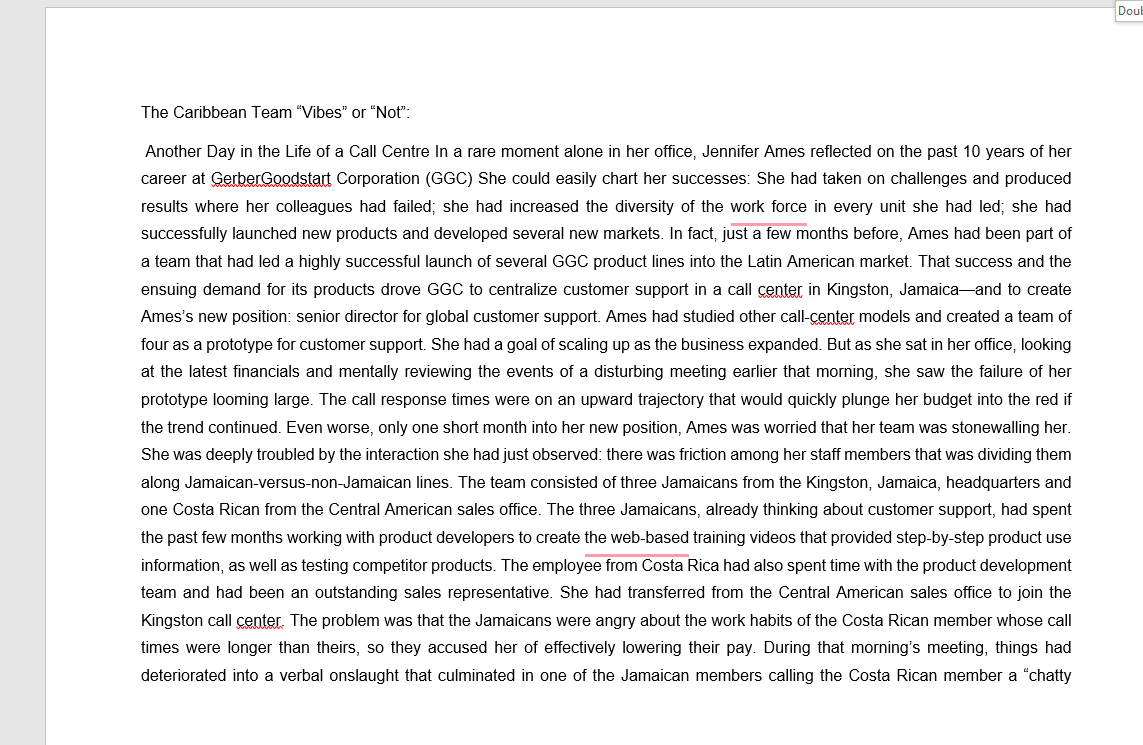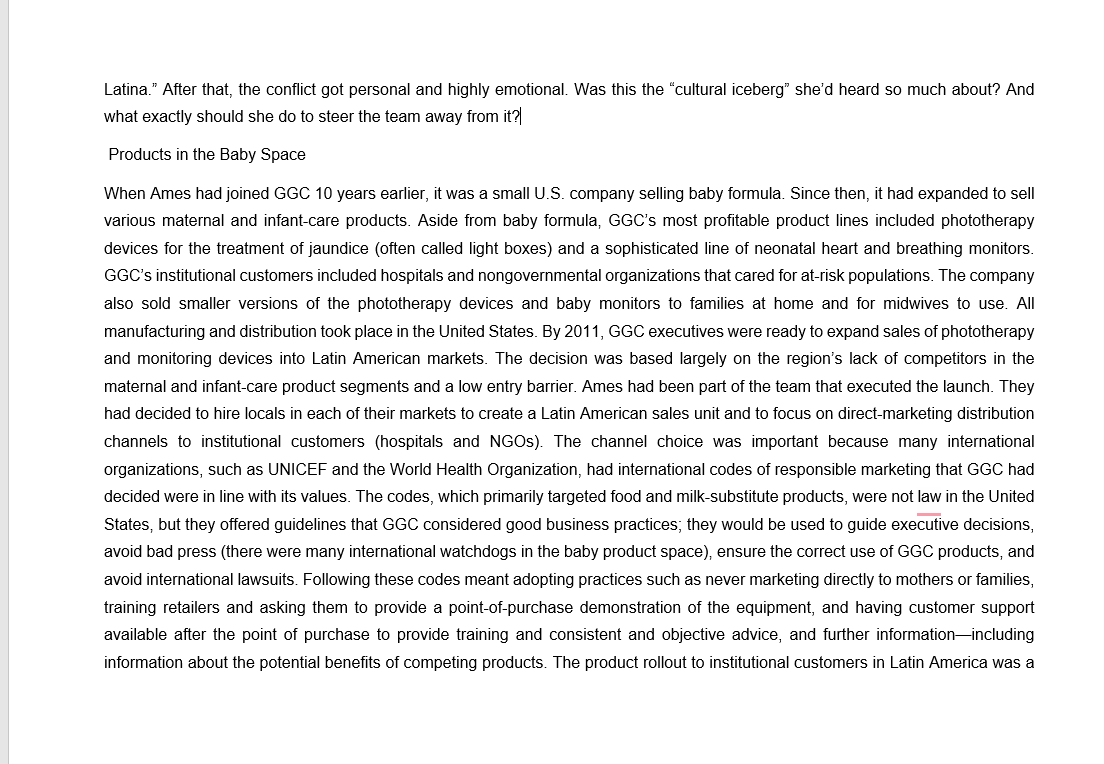The Caribbean Team "Vibes" or "Not": Another Day in the Life of a Call Centre In a rare moment alone in her office, Jennifer Ames reflected on the past 10 years of her career at GerberGoodstart Corporation (GGC) She could easily chart her successes: She had taken on challenges and produced results where her colleagues had failed; she had increased the diversity of the work force in every unit she had led; she had successfully launched new products and developed several new markets. In fact, just a few months before, Ames had been part of a team that had led a highly successful launch of several GGC product lines into the Latin American market. That success and the ensuing demand for its products drove GGC to centralize customer support in a call center in Kingston, Jamaica-and to create Ames's new position: senior director for global customer support. Ames had studied other call-center models and created a team of four as a prototype for customer support. She had a goal of scaling up as the business expanded. But as she sat in her office, looking at the latest financials and mentally reviewing the events of a disturbing meeting earlier that morning, she saw the failure of her prototype looming large. The call response times were on an upward trajectory that would quickly plunge her budget into the red if the trend continued. Even worse, only one short month into her new position, Ames was worried that her team was stonewalling her. She was deeply troubled by the interaction she had just observed: there was friction among her staff members that was dividing them along Jamaican-versus-non-Jamaican lines. The team consisted of three Jamaicans from the Kingston, Jamaica, headquarters and one Costa Rican from the Central American sales office. The three Jamaicans, already thinking about customer support, had spent the past few months working with product developers to create the web-based training videos that provided step-by-step product use information, as well as testing competitor products. The employee from Costa Rica had also spent time with the product development team and had been an outstanding sales representative. She had transferred from the Central American sales office to join the Kingston call center. The problem was that the Jamaicans were angry about the work habits of the Costa Rican member whose call times were longer than theirs, so they accused her of effectively lowering their pay. During that morning's meeting, things had deteriorated into a verbal onslaught that culminated in one of the Jamaican members calling the Costa Rican member a "chatty
The Caribbean Team "Vibes" or "Not": Another Day in the Life of a Call Centre In a rare moment alone in her office, Jennifer Ames reflected on the past 10 years of her career at GerberGoodstart Corporation (GGC) She could easily chart her successes: She had taken on challenges and produced results where her colleagues had failed; she had increased the diversity of the work force in every unit she had led; she had successfully launched new products and developed several new markets. In fact, just a few months before, Ames had been part of a team that had led a highly successful launch of several GGC product lines into the Latin American market. That success and the ensuing demand for its products drove GGC to centralize customer support in a call center in Kingston, Jamaica-and to create Ames's new position: senior director for global customer support. Ames had studied other call-center models and created a team of four as a prototype for customer support. She had a goal of scaling up as the business expanded. But as she sat in her office, looking at the latest financials and mentally reviewing the events of a disturbing meeting earlier that morning, she saw the failure of her prototype looming large. The call response times were on an upward trajectory that would quickly plunge her budget into the red if the trend continued. Even worse, only one short month into her new position, Ames was worried that her team was stonewalling her. She was deeply troubled by the interaction she had just observed: there was friction among her staff members that was dividing them along Jamaican-versus-non-Jamaican lines. The team consisted of three Jamaicans from the Kingston, Jamaica, headquarters and one Costa Rican from the Central American sales office. The three Jamaicans, already thinking about customer support, had spent the past few months working with product developers to create the web-based training videos that provided step-by-step product use information, as well as testing competitor products. The employee from Costa Rica had also spent time with the product development team and had been an outstanding sales representative. She had transferred from the Central American sales office to join the Kingston call center. The problem was that the Jamaicans were angry about the work habits of the Costa Rican member whose call times were longer than theirs, so they accused her of effectively lowering their pay. During that morning's meeting, things had deteriorated into a verbal onslaught that culminated in one of the Jamaican members calling the Costa Rican member a "chatty
Management, Loose-Leaf Version
13th Edition
ISBN:9781305969308
Author:Richard L. Daft
Publisher:Richard L. Daft
Chapter10: Designing Organization Structure
Section: Chapter Questions
Problem 1ED
Related questions
Question

Transcribed Image Text:The Caribbean Team "Vibes" or "Not":
Another Day in the Life of a Call Centre In a rare moment alone in her office, Jennifer Ames reflected on the past 10 years of her
career at GerberGoodstart Corporation (GGC) She could easily chart her successes: She had taken on challenges and produced
results where her colleagues had failed; she had increased the diversity of the work force in every unit she had led; she had
successfully launched new products and developed several new markets. In fact, just a few months before, Ames had been part of
a team that had led a highly successful launch of several GGC product lines into the Latin American market. That success and the
ensuing demand for its products drove GGC to centralize customer support in a call center in Kingston, Jamaica-and to create
Ames's new position: senior director for global customer support. Ames had studied other call-center models and created a team of
four as a prototype for customer support. She had a goal of scaling up as the business expanded. But as she sat in her office, looking
at the latest financials and mentally reviewing the events of a disturbing meeting earlier that morning, she saw the failure of her
prototype looming large. The call response times were on an upward trajectory that would quickly plunge her budget into the red if
the trend continued. Even worse, only one short month into her new position, Ames was worried that her team was stonewalling her.
She was deeply troubled by the interaction she had just observed: there was friction among her staff members that was dividing them
along Jamaican-versus-non-Jamaican lines. The team consisted of three Jamaicans from the Kingston, Jamaica, headquarters and
one Costa Rican from the Central American sales office. The three Jamaicans, already thinking about customer support, had spent
the past few months working with product developers to create the web-based training videos that provided step-by-step product use
information, as well as testing competitor products. The employee from Costa Rica had also spent time with the product development
team and had been an outstanding sales representative. She had transferred from the Central American sales office to join the
Kingston call center. The problem was that the Jamaicans were angry about the work habits of the Costa Rican member whose call
times were longer than theirs, so they accused her of effectively lowering their pay. During that morning's meeting, things had
deteriorated into a verbal onslaught that culminated in one of the Jamaican members calling the Costa Rican member a "chatty
Doub

Transcribed Image Text:Latina." After that, the conflict got personal and highly emotional. Was this the "cultural iceberg" she'd heard so much about? And
what exactly should she do to steer the team away from it?
Products in the Baby Space
When Ames had joined GGC 10 years earlier, it was a small U.S. company selling baby formula. Since then, it had expanded to sell
various maternal and infant-care products. Aside from baby formula, GGC's most profitable product lines included phototherapy
devices for the treatment of jaundice (often called light boxes) and a sophisticated line of neonatal heart and breathing monitors.
GGC's institutional customers included hospitals and nongovernmental organizations that cared for at-risk populations. The company
also sold smaller versions of the phototherapy devices and baby monitors to families at home and for midwives to use. All
manufacturing and distribution took place in the United States. By 2011, GGC executives were ready to expand sales of phototherapy
and monitoring devices into Latin American markets. The decision was based largely on the region's lack of competitors in the
maternal and infant-care product segments and a low entry barrier. Ames had been part of the team that executed the launch. They
had decided to hire locals in each of their markets to create a Latin American sales unit and to focus on direct-marketing distribution
channels to institutional customers (hospitals and NGOs). The channel choice was important because many international
organizations, such as UNICEF and the World Health Organization, had international codes of responsible marketing that GGC had
decided were in line with its values. The codes, which primarily targeted food and milk-substitute products, were not law in the United
States, but they offered guidelines that GGC considered good business practices; they would be used to guide executive decisions,
avoid bad press (there were many international watchdogs in the baby product space), ensure the correct use of GGC products, and
avoid international lawsuits. Following these codes meant adopting practices such as never marketing directly to mothers or families,
training retailers and asking them to provide a point-of-purchase demonstration of the equipment, and having customer support
available after the point of purchase to provide training and consistent and objective advice, and further information including
information about the potential benefits of competing products. The product rollout to institutional customers in Latin America was a
Expert Solution
This question has been solved!
Explore an expertly crafted, step-by-step solution for a thorough understanding of key concepts.
Step by step
Solved in 2 steps

Recommended textbooks for you

Management, Loose-Leaf Version
Management
ISBN:
9781305969308
Author:
Richard L. Daft
Publisher:
South-Western College Pub

Management, Loose-Leaf Version
Management
ISBN:
9781305969308
Author:
Richard L. Daft
Publisher:
South-Western College Pub